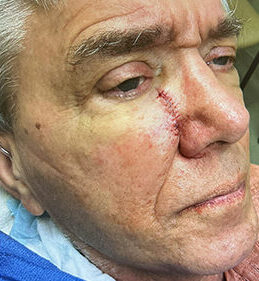My cancer diagnosis and surgery have reminded me of Fabry facts
My risks have changed since my heart transplant, but I still have them
Written by |

Fabry disease can be an indirect cause of cancer after a transplant. I’m an example of that possibility.
After my 2020 heart transplant at Duke University Medical Center, I was told that my risk of developing cancer was higher. The organ transplant antirejection medications I must take for the rest of my life weaken my immune system and increase my risk.
I wasn’t sure what to think of this information until this year, when on May 15 I was diagnosed with basal cell carcinoma on my face. It was a surprise, especially since I didn’t see the cancer myself. After my transplant, I was encouraged to see a dermatologist for an annual skin cancer checkup. Since May, I’ve been on a six-month interval for these skin cancer screenings.
During that routine screening in May, my dermatologist noticed an abnormality and took a biopsy, which revealed my diagnosis. I was scheduled to have a Mohs procedure on July 10. During that surgery, the visible tumor and a thin layer of tissue around it were removed. The surgery was successful, with all the cancer removed. No chemo or radiation therapy was recommended.
After learning of my cancer, I imagined that the postsurgical crater on my face would be smaller than what I ended up with. But my surgeon did a great job stitching me up. The new scar joined the no less than two dozen scars I’ve collected from other surgeries for a variety of issues.
Threats to my life

My face after cancer surgery but before stitches. (Courtesy of Jerry Walter)

My face after surgery and stitches. (Courtesy of Jerry Walter)
Since I was 25 years old (44 years ago, when I was diagnosed with Fabry), I’ve had a higher risk of premature death looming over me from the potential manifestations of heart disease, kidney disease, lung disease, or stroke. I’m familiar, but not preoccupied, with having a lingering sense of an early grim fate.
Historically, many people have died prematurely from complications of Fabry disease. Our prognosis has been much better in recent years with kidney dialysis and transplants, heart transplants, and approved treatments in the United States and abroad that can halt or slow disease progression.
Most of the time, I subdued my sense of risk in the back of my mind. At other times, however, it’s risen to the surface when I experienced life-threatening events over the years.
The most serious threat to my life hasn’t been the more than 20 years of stage 3 chronic kidney disease, nor the lung function that’s declined to less than 50% of normal at its lowest point. It’s been the years of progressive heart failure I experienced, which caused chronic fatigue, muscle weakness, shortness of breath, and an increasingly sedentary lifestyle.
My reminder of the risk
After getting my new and healthy heart, I’ve been relieved of the Fabry burden of possible death by heart failure, heart attack, or sustained heart arrhythmias. I’m extremely fortunate and grateful to have this second chance; I’m a new person with a good life and much more to look forward to. But as I’ve been reminded, my higher risk of cancer has replaced my risk of premature death by heart complications.
According to the Centers for Disease Control and Prevention, “Some examples of risk factors for cancer are alcohol, family health history, human papillomavirus (HPV), obesity, and tobacco.” That webpage doesn’t note the risk of cancer from having a compromised immune system after solid organ transplants. People, including myself, tend to learn about that individually.
In a 2020 issue of the journal Cancer Medicine, one “study [that] included 116,438 transplant recipients (51,173 heart transplant recipients and 65,265 lung transplant recipients) … found that heart and lung transplant populations had significantly increased risks of cancer compared with the general population.”
So from this point on, I’ll continue to do what I’ve always done and be proactive about managing my health. I’ll be an influencer! And “be an influencer” is the theme of the National Fabry Disease Foundation‘s upcoming annual Fabry Family Education Conference and Fabry Family Camp, both scheduled for next month. I’m the foundation’s founder and president.
The most important part of a health management strategy is to take a Fabry-specific treatment. Everything else is secondary.
After taking care of yourself, I hope you’ll be an influencer, too, by telling others how you manage your disease, your health, or your children’s health. Best wishes on your journey with Fabry and the many other conditions and obstacles life throws at you and your family.
Note: Fabry Disease News is strictly a news and information website about the disease. It does not provide medical advice, diagnosis, or treatment. This content is not intended to be a substitute for professional medical advice, diagnosis, or treatment. Always seek the advice of your physician or other qualified health provider with any questions you may have regarding a medical condition. Never disregard professional medical advice or delay in seeking it because of something you have read on this website. The opinions expressed in this column are not those of Fabry Disease News or its parent company, Bionews, and are intended to spark discussion about issues pertaining to Fabry disease.







Narah Cano
Thank you for sharing your life story and experiences to make a difference and influence all our lives.
Diane
The article about the 57 year old woman's diagnosis. shows how much more the medical community needs to learn about when to suspect Fabry. Wow.
Kathy Carlson
It is with admiration of your willingness to share the ups and downs associated with your Fabry disease. It is important we all received treatment for fabry disease with the medicines currently available to us. It is also very important to keep a positive attitude which at times can be difficult. We get one life and need to live it to our fullest. Thank you for all you do.